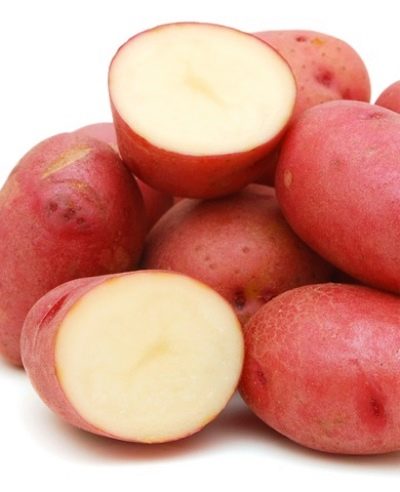
- Authors: Koksharov V.P., Klyukina E.M., Shanina E.P. (FGBNU "Ural Research Institute of Agriculture")
- Year of approval: 2012
- Appointment: dining room
- Tuber size: large
- Tuber weight, g: 108-185
- Peel color: red
- Color of the pulp: light yellow
- Starch content,%: 13,0-16,5%
- Tuber shape: rounded
- Peel structure: smooth
Irbit potato is a high-yielding variety that attracts gardeners with its resistance to various diseases and pests. In addition, the plant is unpretentious to growing conditions, calmly tolerates frosts and temperature extremes.
Breeding history
For the first time in the State Register, Irbit potatoes appeared in 2009. The variety was bred by domestic breeders from the Ural Research Institute of the Russian Agricultural Academy, suitable for growing in the Volgo-Vyatka and West Siberian regions.
Description of the variety
The variety is distinguished by low compact bushes, which makes it possible to organize frequent planting of tubers in the selected area. Other characteristics:
- semi-upright bush;
- the nature of growth is intermediate;
- leaves are medium in size, rich green shade, wavy at the edges;
- the corolla is medium in size.
Potato buds have a pleasant blue-violet hue.
Characteristics of the appearance of the bush and root crops
Irbit potato bushes of compact size delight gardeners with high yields. Root characteristics:
- shape - rounded;
- the skin is smooth, pink-red;
- eyes are small;
- the pulp is yellow.
The average weight of a potato reaches 185 g under good growing conditions. The starch content in the pulp ranges from 13% to 16.5%.
Purpose and taste of tubers
Irbitsky potato roots are great for preparing main courses and salads. The pulp is moderately boiled, which allows you to easily get the dish of the desired consistency.
Maturation
The Irbitsky variety belongs to the group of plants with an average ripening period. On average, root crops are formed within 90 days of planting potatoes.
Yield
One hectare gives from 252 to 400 centners. From a bush under good growing conditions, it is possible to collect up to 8-10 large potatoes.
Growing and care
You can get a high yield only if you take into account all the recommendations and rules of care. Before planting potatoes, you need to prepare:
- 3 weeks before planting, remove the tubers from the storage and select, leaving large root crops without defects;
- place potatoes in a box and put in a warm place under the light;
- about 1-2 days before planting, treat root crops with growth stimulants and preparations that will protect against diseases and pests;
- cut large potatoes so that each piece contains 3 eyes.
In addition to a proper fit, care must also be taken. The basic approaches to growing potatoes represent a standard list of procedures.
- Watering. Potatoes are not picky about regular watering. Therefore, gardeners are advised to add water to the soil immediately after planting, as well as during flowering and active formation of tubers. Before watering, the water should be defended.
- Top dressing. The first fertilizers are applied to the ground even before the potatoes are planted. Usually, organic compounds in the form of wood ash, compost or humus are used as top dressing. It is recommended to re-fertilize the soil during the period of growth of bushes and the appearance of the first buds. In this case, you can use mineral compositions.
- Hilling.The procedure stimulates the formation of root crops. The first time the rows of potatoes are hilled when the bush rises by 10-12 cm. Further, the hilling is carried out as needed, usually after watering or rain.
- Weeding. Removing weeds accelerates the growth of potato bushes and allows for a rich harvest. On average, per season, you should go to the site three times to remove weeds. You can do this before hilling the potatoes.
Additionally, gardeners recommend loosening the soil. This is required to saturate the soil with oxygen.

Planting potatoes is one of the main spring activities traditional for Russian gardeners. There are many ways to plant this vegetable, allowing you to get a good harvest in different conditions and climates. Before planting, you need to carefully prepare the planting material, correctly determine the timing, competently prepare the soil.


Soil requirements
Irbitsky is a variety that is unpretentious to growing conditions. Potatoes can be planted in any soil, the only requirement is acidity. The pH value should not rise above 6. If necessary, the acidity of the soil can be reduced with lime fertilizers.

Disease and pest resistance
The variety has strong immunity against common potato infections. If affected areas are found, they must be removed, as well as preventive treatment with special compounds. You can buy drugs to strengthen the immune system of potatoes in gardening stores.
If the potatoes have attracted the attention of Colorado potato beetles or potato moths, then you should use folk remedies. Preparations based on natural ingredients will not harm the soil and the inhabitants of the garden plot.

Potatoes are a popular vegetable crop that many gardeners planted on their site. But growing a bountiful harvest of tasty and large tubers is unlikely to succeed if the beds are not properly protected from the most common diseases and pests. Often, the development of diseases of various etiologies of potatoes goes unnoticed, so it is important to identify the problem in time and eliminate it.
















































































